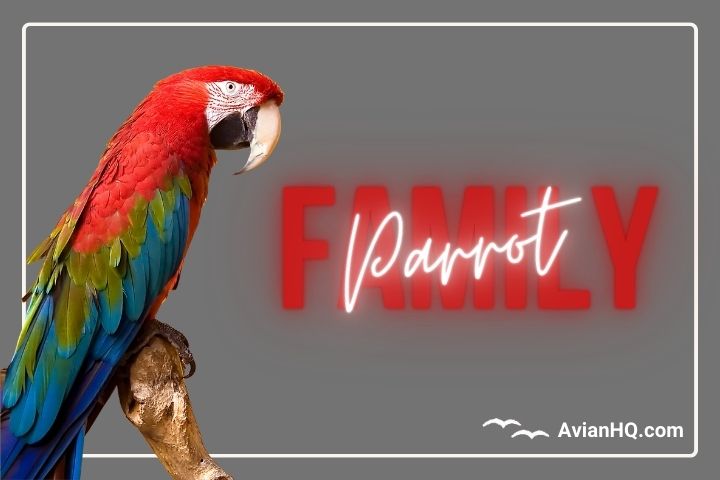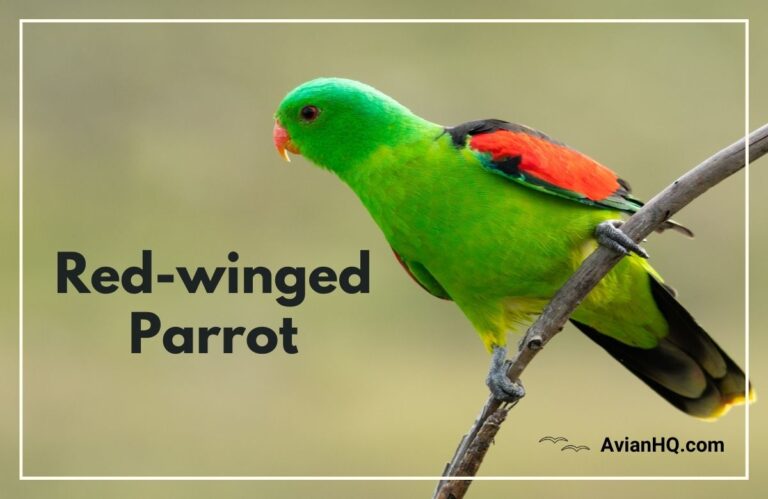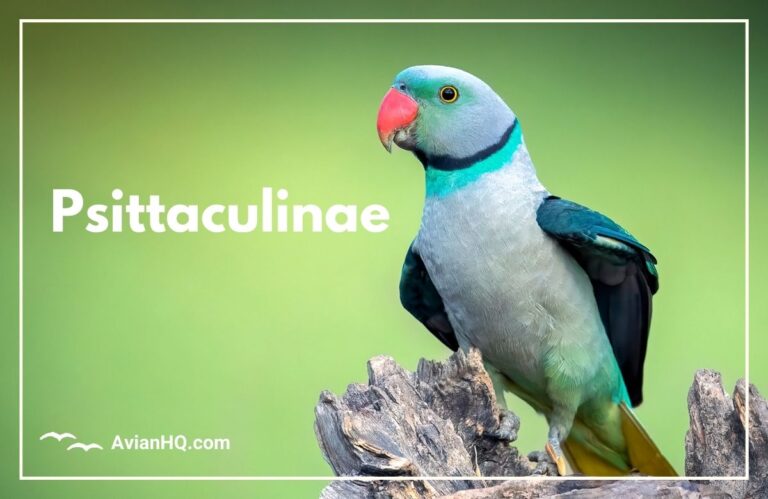An In-Depth Guide to the Parrot Family Psittaculidae
Parrots of the family Psittaculidae stand out with their bright plumage, curved beaks, intelligence, and often loud voices. This diverse family includes such popular species as lories, lorikeets, hanging parrots, and fig parrots.
You may have seen these colorful birds in pet stores and wondered about their origins. Or maybe you caught a glimpse of them soaring over rainforest canopies in nature documentaries. Though related, Psittaculidae parrots have varied characteristics and habitats across the world.
In this guide, you’ll learn what defines this family within the larger parrot order. We’ll explore their taxonomy, physical traits, geographic ranges, behaviors, relationships with humans, and conservation needs. Whether you’re a bird watcher or simply intrigued by their beauty, you’ll gain deeper insight into these captivating creatures.
Our tour through the Psittaculidae world will spotlight features that make them unique. You’ll also understand why increased habitat loss can threaten delicate species. Parrots have evolved fascinating adaptations to their environments too.
By the end, your eyes will be opened to the diversity within just this one family. You’ll also learn ways to support responsible aviculture and conservation. So let’s take flight on an in-depth exploration of all things Psittaculidae parrots!
Taxonomy and Classification: Ordering the Parrot Family Tree
Psittaculidae belongs to the larger order Psittaciformes, encompassing all parrot species. But how did scientists classify this particular family?
Taxonomy has evolved over centuries, as biology advanced. In the 18th century, Carl Linnaeus introduced the system still used today. He grouped parrots into the genus Psittacus. But more genera emerged as differences were noted.
By the 1830s, Psittaculidae took shape as a family. Key distinguishing traits included specialized lories in the genus Lorius and hanging parrots in Loriculus. In 2014, the order contained 399 species across 92 genera.
Today, the Psittaculidae family includes:
- Loriinae – lories and lorikeets
- Cyclopsittacinae – fig parrots like the double-eyed fig parrot
- Agapornithinae – lovebirds
- Psittaculinae – diverse species like hanging parrots
You can see how taxonomy groups parrots based on anatomy, behavior, geography, and genetics. Their constant refinement reveals new evolutionary relationships. Proper classification also aids conservation efforts.
Now that we’ve mapped out the parrot family tree, let’s look at key physical features across genera and species. Vibrant colors are one hallmark, but subtle variations reveal how Psittaculidae members have adapted to their environments.
Physical Characteristics: Feathers, Bills, and Sizes Galore
Psittaculidae parrots flaunt a rainbow of eye-catching plumage. But differences in size, bills, tails, and other features help identify genera and species.
Most range from 9 to 16 inches long. But the palm cockatoo, a member of the Probosciger genus, reaches up to 24 inches tall! The buff-faced pygmy parrot (Micropsitta) measures under 3 inches at maturity.
Various species have red, orange, yellow, green, blue, and violet feather colors. The eclectus parrot displays perhaps the most striking dichotomy. Males are bright green while females appear crimson and purple.
Specialized bills allow feeding on various foods. Lories and lorikeets have brush-tipped tongues for nectar. Fig parrots like the blue-crowned hanging parrot have strong jaws to break through fruit.
You’ll also notice short blunt tails on hanging parrots that help them climb headfirst down branches. Longer tapering tails in lorikeets act as rudders in flight. Crested heads appear in species like Goffin’s cockatoo.
With size, color, bills, and tails adapting to niche habitats, you can see the diversity of the Psittaculidae on display! Next we’ll look at the global reach of these evolutionary adaptations.
Geographical Distribution and Habitat: Global Reach of the Parrot Family
Psittaculidae parrots live on tropical and subtropical habitats across the world. Different genera dominate certain continents and regions.
Most parakeets reside in Asia, Africa, and Oceania. Australia houses the greatest diversity, with over 50 native species like the turquoise parrot. South America also hosts parakeets, but is better known for macaws.
Africa claims species like the Meyer’s parrot. Madagascar and nearby islands feature rare endemics, including the golden parakeet. Lories largely occupy Indonesia and the Philippines.
Fig parrots reside in rainforests and woodlands worldwide. Hanging parrots populate South Asia through Maritime Southeast Asia. Lovebirds live throughout Africa.
Sadly, deforestation and climate change disrupt native habitats. As human development expands, conservation helps offset the impact through programs like:
- Creating protected reserves
- Reforestation initiatives
- Captive breeding
Saving Psittaculidae means saving forests. When you support responsible eco-tourism and research, you also sustain endangered species. Now let’s learn more about the behaviors defining Psittaculidae in the wild.
Behavior and Lifestyle: Social Structures, Communication, and More
Parrots live in a variety of social structures, from solitary to large flocks. They also have complex communication methods and foraging behaviors.
Some parakeets and hanging parrots lead mostly solitary lives, only pairing up to breed. Others like monk parakeets build communal nests housing hundreds. Flocks may congregate at clay licks to supplement diets.
Vocalizations play a key role. Some mimic human speech through unique sound chambers. Lovebirds are named for their habit of bonding pairs. SIGNALS direction changes during flight.
Specialized bills allow eating seeds, fruits, nectar, even insects or small animals. Strong legs and feet help grip branches. Most are nimble climbers.
Roosting and nesting habits vary between species. Australian king parrots nest in termite mounds while buff-faced pygmy parrots roost in tree hollows. Fig parrots nest in tree cavities.
We’ve covered a lot of ground learning about Psittaculidae diversity. Now let’s look at popular genera up close through detailed species profiles. The biology and behaviors will come to life in these featured parrots.
Species Profiles: Spotlight on Popular Parrots
To better understand the Psittaculidae family, let’s highlight some prominent genera and species. We’ll showcase their unique traits and fascinating facts.
Lories and Lorikeets
These nectar-eating parrots display vivid red, orange, yellow, green, and blue plumage. Their brush-tipped tongues help gather pollen and nectar. Many display bright red beaks.
The red lory inhabits Indonesia and islands near Australia. Green fig parrots live in forests of Southeast Asia and Maritime Southeast Asia. The rainbow lorikeet of Australia is breathtakingly colorful.
Hanging Parrots
As the name suggests, these parrots use their zygodactyl toes to grip branches. Short blunt tails aid climbing. Species like the Sangihe hanging parrot of Indonesia have bright green bodies contrasting with red heads.
Fig Parrots
So named for their love of figs, these chunky short-tailed parrots live in New Guinea, Australia, and surrounding islands. Most are green with hints of red or yellow. The double-eyed fig parrot has pale blue patches around both eyes.
Ringneck Parakeets
These popular parakeets have long tails and a colored ring around their neck. The Indian ringneck parakeet exhibits green body feathers and a pinkish collar. The African ringneck or rose-ringed parakeet has a black collar necklace.
Lovebirds
These African parrots form strong pair bonds. They nest in colonies and exhibit a variety of green, orange, yellow, and blue hues. The peach-faced lovebird is commonly kept as a pet. Madagascar is home to the endangered grey-headed lovebird.
Relationship with Humans: Cultural Significance, Pets, and Conservation
Humans have interacted with Psittaculidae parrots for thousands of years. They’ve been symbols in art and culture, popular pets, and subjects of conservation efforts.
Indigenous groups like Australia’s Tiwi people feature parrots in folklore. Parakeet mummies were found in ancient Egyptian tombs. Today they appear in logos, animation, and marketing.
The pet trade drives both legal and illegal trafficking of wild parrots. Breeders work to meet demand humanely. Responsible ownership and aviculture helps protect threatened species.
Habitat loss, climate change, and invasive predators put many parrots at risk. The golden parakeet numbers less than 1000 birds in the wild. Ecotourism aids communities and fosters habitat protection.
When admiring parrots, consider supporting reputable breeders and reserves. Shopping wisely helps spare populations from further decline.
Exploring the Captivating World of Parrots
Our journey through the Psittaculidae family has highlighted its diversity. We’ve covered taxonomy, anatomy, habitats, behaviors, species profiles, and conservation needs of these intelligent and vocal birds.
Seeing their vibrant colors and learning about differences between genera gives new insight. But common threads like strong curved bills and zygodactyl feet unite them. Social structures range from solitary to highly flocking across habitats worldwide.
Sadly habitat loss threatens many species. Responsible pet ownership and ecotourism support can counter the declines. When you admire parrots, consider how small actions multiply to protect endangered populations.
The next time you see a parrot, look closer at its size, shape, and colors. Note field marks that indicate species and origin. Listen for mimicry or wild raucous calls. You now have the knowledge to identify signatures of its Psittaculidae membership.
Our journey through the parrot world continues as we next explore specific species and genera. For now, remember that nature’s diversity relies on humans valuing and supporting all species, even the winged ones.






